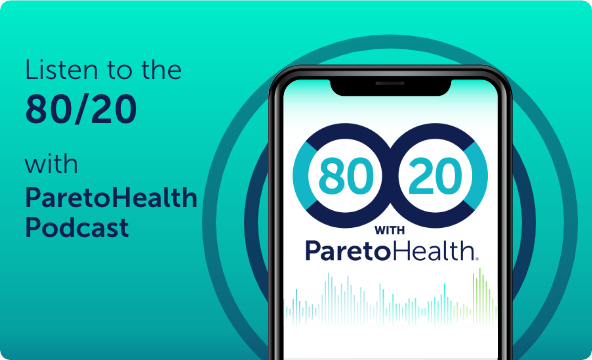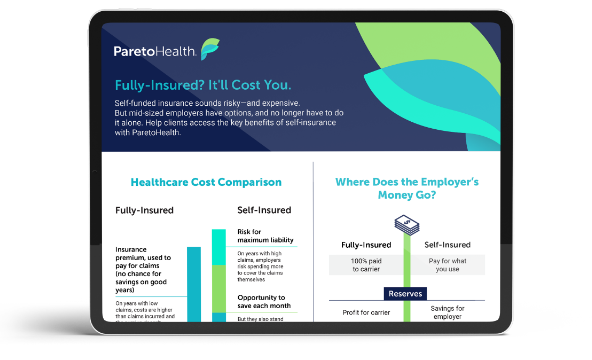Level-Funded Insurance Plans: All You Need to Know in Five Minutes
Learn what level-funded insurance plans are – their pros and cons, appeals, and downsides.
What is a level-funded insurance plan? The simple answer is that it’s another type of health plan.
Another one? Yes, and if you’re overwhelmed by the options, you’re right to feel that way. But the more you know, the more informed your employee healthcare-related decisions can be. So, let’s break it down.
Essentially, level-funded health plans combine elements of fully insured health plans and self-insured health plans to give employers a middle ground¹.
As you may remember, companies get comprehensive coverage with fully insured plans², but it comes at a high cost that increases annually. Plus, there’s a long list of other downsides that many employers are starting to realize aren’t worth the cost.
On the other end of the spectrum, self-insured³ plans allow companies to pay the cost of the claims as they come in. Companies can spend according to their specific needs, which results in financial savings. The downside? Self-insurance comes with the risk of volatile, potentially high claims costs that an employer may be unable to afford.
As a seemingly happy medium (at least on the surface), level-funded plans combine elements of both fully insured and self-insured plans, the good and the bad. The idea here is that companies can get the coverage of a fully insured plan while having certain flexibilities and lower costs of self-insured plans.
So how does a level-funded plan work?
For the most part, level-funded plans work similarly to a fully insured plan. Companies pay a fixed monthly payment (the premium) each month to the insurance carrier. That money will be used to cover costs that include:
- Administration (the estimated cost for insurers to administer the plan)
- Stop-Loss coverage (that protects against catastrophic losses and large claims)
- Maximum claims pre-funding (which is the maximum cost a company pays for claims)
So, what’s the appeal of a level-funded plan?
The most popular reasons include:
- They come with a fixed, predictable monthly cost
- The plans can be flexible and be chosen to fit the company’s needs
- Insurers may provide claims data for insights on health spend
- Possibility of refunds
Companies may get refunds if their total claims, costs, and expenses are less than the maximum claims paid for the plan’s duration at pre-funding, typically at the year’s end and right before contract renewal.
Sounds great, right? But hold on.
Here’s what they don’t tell you about level-funded plans—
All the benefits mentioned heavily depend on the insurer. And for each of those benefits, some downsides emerge too.
The most apparent downside?
Level-funded plans work a lot like fully insured plans. Yes, it’s a fixed cost, and predictability is great for planning, but if you’re predictably paying for a feature that doesn’t fully benefit you, it’s time to rethink things.
Like a fully insured plan, the “fixed” costs rise with time. If you had a “bad year” due to high claims costs, your premium might skyrocket the next time you renew your contract!
And then we have the “refunds.” They’re great, but only if you manage to get one.
Refunds aren’t certain, and the refund percentage isn’t significant even in a “good year.” On average, most carriers give less than a 50% refund, retaining the majority of your unused funds.
You can think of it as a “heads you lose, tails you tie” situation. While you take the full losses in a bad year, you have to split the winnings with the carrier in a good year, too. In other words, the house always wins because the model is tilted in the carrier’s favor.
Also, depending on the insurer, refund policies come with many conditions and can be very hard to actually collect. Often, the “refund” comes in as credit to use towards next year’s expenses, forcing companies to renew another year to even receive it. Plus, it’s not usually a physical check you can reinvest into your business. You don’t technically see the money come back to you again.
On the off chance that you want to switch carriers at your renewal? No matter how “good” your year was, forget your refund altogether.
So, just as you pay for a fully insured plan to cover claims costs—costs that you may or may not end up incurring—you also pay for the possibility of a refund in a level-funded plan. Basically, if you don’t generate claims, you are wasting money, and if you do, expect your premiums to rise. Especially in a bad year—your premiums could shoot up significantly.
At the end of the day, whether you get the value you pay for is down to factors you can’t control.
It’s worth noting that a level-funded plan may be a good foray into self-insurance for employers who are too small or not the right fit for a pure self-insured plan, but drawbacks exist.
However, we have options for you.
When you become a part of ParetoHealth, you get the freedom and flexibility of a self-insured plan and the security of a fully insured plan – without the downsides.
References
¹ParetoHealth (2022) Employee Health Benefits Financing Alternatives. Retrieved June 20, 2022, from https://docs.google.com/gview?url=https://paretohealth.com/wp-content/uploads/2021/07/Financing-Alternative-Infographic.pdf
² ParetoHealth (2022) What is a Fully Insured Plan? Retrieved June 15, 2022, from https://paretocaptive-my.sharepoint.com/:w:/r/personal/dibble_paretohealth_com/_layouts/15/Doc.aspx?sourcedoc=%7Bc7440ff3-9e7e-4085-974b-1fa82db0ae5e%7D&action=view&wdparaid=7430CB5C&cid=b177692d-229a-49e1-9362-843de9c51ea5
³ ParetoHealth (2022) What is Self-Insurance? Retrieved June 15, 2022, from https://paretocaptive-my.sharepoint.com/:w:/r/personal/dibble_paretohealth_com/_layouts/15/Doc.aspx?sourcedoc=%7B4a235fc4-a117-452d-9c11-be024c4c0bbe%7D&action=view&wdparaid=32A19736&cid=098fb001-7a56-4ade-b238-fcd02a160933
There’s a Better Way to Do Employee Health Benefits
Join an upcoming webinar to learn how ParetoHealth turnkey employee health benefits solutions deliver the scale and resources mid-sized businesses need to self-insure with total confidence. By combining a captive model with comprehensive medical and pharmacy cost containment strategies, our members realize significant cost savings with multi-year protection.
 December 7, 2023
December 7, 2023 






